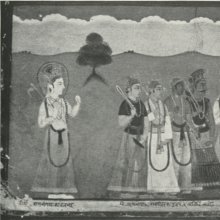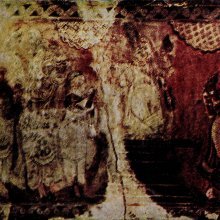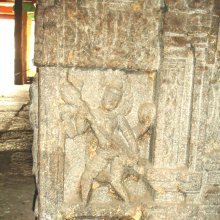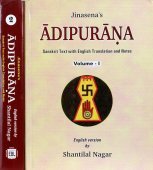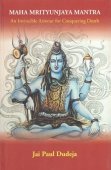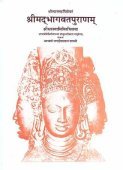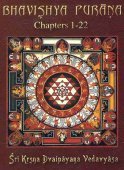Markandeya, Mārkandeya, Mārkaṇḍeya: 29 definitions
Introduction:
Markandeya means something in Hinduism, Sanskrit, the history of ancient India, Marathi. If you want to know the exact meaning, history, etymology or English translation of this term then check out the descriptions on this page. Add your comment or reference to a book if you want to contribute to this summary article.
Images (photo gallery)
In Hinduism
Purana and Itihasa (epic history)
Source: archive.org: Puranic Encyclopedia1) Mārkaṇḍeya (मार्कण्डेय).—The son of Mṛkaṇḍu. He was a great devotee of Śiva. Genealogy. Bhṛgu, son of Brahmā, begot of his wife Khyāti a daughter named Lakṣmī and two sons named Dhātā and Vidhātā. (See full article at Story of Mārkaṇḍeya from the Puranic encyclopaedia by Vettam Mani)
2) Mārkaṇḍeya (मार्कण्डेय).—A famous holy place. This place is situated about sixteen miles to the north of Kāśī at a place where the rivers Gaṅgā and Gomatī meet. He who visits this place would get the benefit of doing an Agniṣṭomayajña. Not only that, he would lift the prestige of his family. (Śloka 80, Chapter 34, Vana Parva).
Source: archive.org: Shiva Purana - English TranslationMārkaṇḍeya (मार्कण्डेय) is the name of an ancient Sage (Muni), according to the Śivapurāṇa 2.3.39 (“The gods arrive at Kailāsa”).—Accordingly: “[...] Lord Śiva thus requested by Viṣṇu, and being himself eager to follow worldly conventions performed the same duly. Authorised by Him, I performed all the rites conducive to prosperity, assisted by the sages. The sages [e.g., Mārkaṇḍeya, ...], and other sages came to Śiva. Urged by me they performed the sacred rites duly. All of them who had mastered the Vedas and Vedāṅgas performed the safety rites for Śiva and tied the auspicious thread round his wrist. [...]”.
Source: Cologne Digital Sanskrit Dictionaries: The Purana Index1a) Mārkaṇḍeya (मार्कण्डेय).—A Siddha not lost in deluge;1 son of Mṛkaṇḍa;2 his firm and non-parallelled tapas and vow of celibacy; saw the Puruṣa sleeping on a leaf of the vaṭavṛksa; his āśrama near the Himālayas on a Śila-citra; Indra sent the God of Love, Apsaras and others to disturb him, but in vain; the mahātmā, seeing Hari in Nara-Nārāyaṇa form praised him; pleased with him as one who would be ever meditating on his feet Hari showed him what a pralaya was; Pārvatī and Śiva. saw him, and were praised; when Śiva offered to grant him anything he wanted, he expressed his wish to be ever devoted to him and Hari; pleased with him Śiva went away with Pārvatī; this worthy son of the Bhṛgu race having earned Yogic vision and absolutely devoted to Hari even now goes about the world;3 an authority on Rāma's story.4
- 1) Bhāgavata-purāṇa VI. 15. 12; Matsya-purāṇa 2. 13; 186-3.
- 2) Bhāgavata-purāṇa IV. 1. 45.
- 3) Ib. XII. Chh. 8, 9 and 10.
- 4) Ib. VII. 1. 44.
1b) A contemporary of Dattātreya; Purohita, the fourth incarnation of Dāttātreya, born to help him;1 narrated the mārkaṇḍeya purāṇa;2 acted as Brahmā in Paraśurāma's sacrifice.3
- 1) Brahmāṇḍa-purāṇa II. 33. 11; III. 73. 89; Matsya-purāṇa 47. 242; 53. 26; Vāyu-purāṇa 98. 89; 109. 24; 112. 34.
- 2) Matsya-purāṇa 47. 242; 53. 26.
- 3) Brahmāṇḍa-purāṇa III. 47. 46; IV. 39. 55.
1c) Speaks of the greatness of the Narmadā to Yudhiṣṭhira;1 came to Syamantapāncaka to see Kṛṣṇa.2
1d) A son of Manasvinī and Mṛkaṇḍu;1 wife Dhūmrapatnī and son Vedaśiras;2 present at Rāma's abhiṣeka.3
- 1) Vāyu-purāṇa 28. 5; Viṣṇu-purāṇa I. 10. 4.
- 2) Brahmāṇḍa-purāṇa II. 11. 7.
- 3) Viṣṇu-purāṇa IV. 4. 99.
1e) A disciple of Indra Pramati entrusted with a Samhitā; his son and grandson were respectively Satyaśravas and Satyahita who traditionally handed it down.*
- * Vāyu-purāṇa 60. 27-28.
1f) The sages, descendants and sons of Pīvarī and Vedaśiras.*
- * Vāyu-purāṇa 28. 6.
1g) A Mahā Purāṇa told by Mārkaṇḍeya; containing 9000 ślokas; he who copies it and makes a gift of it in the month of Kārttika attains the fruits of Puṇḍarīka yajña.*
- * Bhāgavata-purāṇa XII. 7. 24; 13. 5; Vāyu-purāṇa 104. 4; Viṣṇu-purāṇa III. 6. 21; Matsya-purāṇa 53. 26-7.
Mārkaṇḍeya (मार्कण्डेय) or Śveta, the son of Sage Mṛkaṇḍu was born to a couple when they propitiated Śiva with their prayers. At the time of granting them their wish, Śiva gave them a choice between an intelligent son with a short life or an idiot, living for hundred years. Mṛkaṇḍu opted for an intelligent child. In course of time the couple begot a son and they called him Mārkaṇḍeya. The young Mārkaṇḍeya was not only extremely intelligent but also a great devotee of Śiva.
Source: JatLand: List of Mahabharata people and placesMārkaṇḍeya (मार्कण्डेय) refers to the name of a Tīrtha (pilgrim’s destination) mentioned in the Mahābhārata (cf. II.82.70). Note: The Mahābhārata (mentioning Mārkaṇḍeya) is a Sanskrit epic poem consisting of 100,000 ślokas (metrical verses) and is over 2000 years old.
Source: Shodhganga: The saurapurana - a critical studyMārkaṇḍeya (मार्कण्डेय) is the son of Mṛkaṇḍu who was born from Niyati (son of Meru) and Vidhātā: one of the three daughters of Bhṛgu and Khyāti, according to the Vaṃśa (‘genealogical description’) of the 10th century Saurapurāṇa: one of the various Upapurāṇas depicting Śaivism.—Accordingly, Dhātā and Vidhātā became the Sons-in-law of Meru marrying Āyati and Niyati respectively. Prāṇa was born form Dhātā and Mṛkaṇḍu was born from Vidhātā. Prāṇa had a son named Vedaśiras and the son of Mṛkaṇḍu was Mārkaṇḍeya.

The Purana (पुराण, purāṇas) refers to Sanskrit literature preserving ancient India’s vast cultural history, including historical legends, religious ceremonies, various arts and sciences. The eighteen mahapuranas total over 400,000 shlokas (metrical couplets) and date to at least several centuries BCE.
Vyakarana (Sanskrit grammar)
Source: Wikisource: A dictionary of Sanskrit grammarMārkaṇḍeya (मार्कण्डेय).—An old grammarian, who wrote a grammar of Praakrta languages which is known by the name प्राकृतसर्वस्व (prākṛtasarvasva).

Vyakarana (व्याकरण, vyākaraṇa) refers to Sanskrit grammar and represents one of the six additional sciences (vedanga) to be studied along with the Vedas. Vyakarana concerns itself with the rules of Sanskrit grammar and linguistic analysis in order to establish the correct context of words and sentences.
Natyashastra (theatrics and dramaturgy)
Source: Wisdom Library: Nāṭya-śāstraMārkaṇḍeya (मार्कण्डेय) is the name of a sage who was in the company of Bharata when he recited the Nāṭyaveda them, according to the Nāṭyaśāstra chapter 35. Accordingly, they asked the following questions, “O the best Brahmin (lit. the bull of the twice-born), tell us about the character of the god who appears in the Preliminaries (pūrvaraṅga). Why is the sound [of musical instruments] applied there? What purpose does it serve when applied? What god is pleased with this, and what does he do on being pleased? Why does the Director being himself clean, perform ablution again on the stage? How, O sir, the drama has come (lit. dropped) down to the earth from heaven? Why have your descendants come to be known as Śūdras?”.

Natyashastra (नाट्यशास्त्र, nāṭyaśāstra) refers to both the ancient Indian tradition (shastra) of performing arts, (natya—theatrics, drama, dance, music), as well as the name of a Sanskrit work dealing with these subjects. It also teaches the rules for composing Dramatic plays (nataka), construction and performance of Theater, and Poetic works (kavya).
Ayurveda (science of life)
Rasashastra (Alchemy and Herbo-Mineral preparations)
Source: Wisdom Library: Rasa-śāstraMārkaṇḍeya (मार्कण्डेय) or Mārkaṇḍeyarasa is the name of an Ayurvedic recipe defined in the fourth volume of the Rasajalanidhi (chapter 3, grahaṇī: chronic diarrhoea). These remedies are classified as Iatrochemistry and form part of the ancient Indian science known as Rasaśāstra (medical alchemy). However, since it is an ayurveda treatment it should be taken with caution and in accordance with rules laid down in the texts.
Accordingly, when using such recipes (e.g., mārkaṇḍeya-rasa): “the minerals (uparasa), poisons (viṣa), and other drugs (except herbs), referred to as ingredients of medicines, are to be duly purified and incinerated, as the case may be, in accordance with the processes laid out in the texts.” (see introduction to Iatro chemical medicines)

Āyurveda (आयुर्वेद, ayurveda) is a branch of Indian science dealing with medicine, herbalism, taxology, anatomy, surgery, alchemy and related topics. Traditional practice of Āyurveda in ancient India dates back to at least the first millenium BC. Literature is commonly written in Sanskrit using various poetic metres.
Pancaratra (worship of Nārāyaṇa)
Source: Wisdom Library: Pancaratra (Samhita list)1) Mārkaṇḍeya (मार्कण्डेय) is the name of an ancient Pāñcarātra Saṃhitā mentioned in the Kapiñjalasaṃhitā: a Pāñcarātra work consisting of 1550 verses dealing with a variety of topics such as worship in a temple, choosing an Ācārya, architecture, town-planning and iconography.—For the list of works, see chapter 1, verses 14b-27. The list [including Mārkaṇḍeya-saṃhitā] was said to have comprised “108” titles, these, different saṃhitās named after different manifestations of the Lord or different teachers. They are all said to be authoritative as the ultimate promulgator of all these is the same Nārāyaṇa.
2) Mārkaṇḍeya (मार्कण्डेय) is the name of an ancient Pāñcarātra Saṃhitā mentioned in the Padmasaṃhitā: the most widely followed of Saṃhitā covering the entire range of concerns of Pāñcarātra doctrine and practice (i.e., the four-fold formulation of subject matter—jñāna, yoga, kriyā and caryā) consisting of roughly 9000 verses.—[Cf. Jñānapāda chapter 1, verses 99-114]—First is explained the folly of following more than one Saṃhitā for a single series of rituals. Then the names of the 108 Tantras of the Pāñcarātra corpus are named [e.g., Mārkaṇḍeya]. Even those who repeat these 108 titles will gain salvation.
3) Mārkaṇḍeya (मार्कण्डेय) or Mārkaṇḍeyasaṃhitā is also mentioned in the Puruṣottamasaṃhitā: a Pāñcarātra text consisting of more than 1800 verses devoted to temple-building and the practical concerns of the Pāñcarātra priestly community.
4) Mārkaṇḍeya (मार्कण्डेय) or Mārkaṇḍeyasaṃhitā is also mentioned in the Bhāradvājasaṃhitā or “Bhāradvāja-kaṇva-saṃhitā”: a Pāñcarātra text comprising some 230 ślokas mainly concerned with basic details concerning temple construction and icon consecration.
5) Mārkaṇḍeya (मार्कण्डेय) or Mārkaṇḍeyasaṃhitā is also mentioned in the Mārkaṇḍeyasaṃhitā: a Pāñcarātra text comprising some 2200 Sanskrit verses mainly dealing with temple-building, iconography, pūjā (worship procedures), utsava (festivities) and prāyaścitta (expiatory measures).
6) Mārkaṇḍeya (मार्कण्डेय) or Mārkaṇḍeyasaṃhitā is also mentioned in the Viśvāmitrasaṃhitā: a Pāñcarātra text comprising some 2600 Sanskrit verses covering topics such as initiation (dīkṣā) and the construction, decoration and consecration of temples and icons, as well as routines of regular and special worship cycles.—
Source: archive.org: Catalogue of Pancaratra Agama TextsMārkaṇḍeya (मार्कण्डेय) is the name of an ancient sage who taught king Pṛthu, as discussed in chapter 1 of the Mārkaṇḍeyasaṃhitā: a Pāñcarātra text comprising some 2200 Sanskrit verses mainly dealing with temple-building, iconography, pūjā (worship procedures), utsava (festivities) and prāyaścitta (expiatory measures).—Description of chapter [tantrānukramaṇikā]: King Pṛthu, having performed his Vedic duties, seeks to know from Mārkaṇḍeya, the famous sage, a way to salvation. The sage offers to instruct the king in the knowledge which Brahmā gave to him, its ultimate source having been Nārāyaṇa (1-25). [...]
Source: Shodhganga: Iconographical representations of Śiva (pancaratra)Mārkaṇḍeya (मार्कण्डेय) or Mārkaṇḍeyasaṃhitā is the name of a Vaiṣṇava Āgama scripture, classified as a rājasa type of the Muniprokta group of Pāñcarātra Āgamas. The vaiṣṇavāgamas represent one of the three classes of āgamas (traditionally communicated wisdom).—Texts of the Pāñcara Āgamas are divided in to two sects. It is believed that Lord Vāsudeva revealed the first group of texts which are called Divya and the next group is called Muniprokta which are further divided in to three viz. a. Sāttvika. b. Rājasa (e.g., Mārkaṇḍeya-saṃhitā). c. Tāmasa.

Pancaratra (पाञ्चरात्र, pāñcarātra) represents a tradition of Hinduism where Narayana is revered and worshipped. Closeley related to Vaishnavism, the Pancaratra literature includes various Agamas and tantras incorporating many Vaishnava philosophies.
Yoga (school of philosophy)
Source: Brill: Śaivism and the Tantric Traditions (yoga)Mārkaṇḍeya (मार्कण्डेय) refers to one of the seven Sages, according to the 17th-century Haṭhayogasaṃhitā: a compilation on Haṭhayoga that borrows extensively from the Haṭhapradīpikā. The opening verses (1.2–3) acknowledge the seven sages, namely Mārkaṇḍeya, Bharadvāja, Marīci, Jaimini, Parāśara, Bhṛgu and Viśvāmitra, for spreading Haṭhayoga in the world. [...] The Haṭhayogasaṃhitā appears to have been the basis of the Gheraṇḍasaṃhitā (eighteenth century), [...]

Yoga is originally considered a branch of Hindu philosophy (astika), but both ancient and modern Yoga combine the physical, mental and spiritual. Yoga teaches various physical techniques also known as āsanas (postures), used for various purposes (eg., meditation, contemplation, relaxation).
General definition (in Hinduism)
Source: Apam Napat: Indian MythologyOnce there was a Brahmana couple who were issueless for a very long time. They practiced severe austerities and penances directed towards Lord Shiva. At last the Lord appeared before them and asked them to state their desire. The asked for a son to give purpose to their lives. Shiva offered them two choices, a son who would be wealthy, powerful and long lived, but of ill character, or a son who would be virtuous, but who will die when he turns sixteen. The Brahmana asked for a son who would be virtuous. The Lord granted the boon and disappeared.
Source: WikiPedia: HinduismMārkaṇḍeya (मार्कण्डेय) is an ancient rishi (sage) from the Hindu tradition, born in the clan of Bhrigu Rishi. He is celebrated as a devotee of both Shiva and Vishnu and is mentioned in a number of stories from the Puranas. He is also mentioned in the Mahabharata. Also see: Markandeya Purana.
Source: Experience Festival: HinduismMarkandeya: The story of Markandeya, who defied death and won immortality as a star in space (SSS-II) Markandeya: As a boy, he knew all the Vedas and Sastras; at 16, he started meditating on Shiva so steadfastly that the day of his death passed him by, and he remained 16 for the next 10 million years. (See also: Markandeya , Hinduism, Hinduism Dictionary, Sanskrit Dictionary, Body Mind and Soul)
Source: India Divine: Sri Markandeya an ancient Hindu rishiMarkandeya was an ancient Hindu rishi (sage), and a devotee of Shiva and Vishnu. Shiva had once rescued Markandeya from Yama, the god of death. Many years ago, a great destruction (Pralaya) took place. The earth was shrouded in darkness and nothing could be seen. There was neither sun nor moon. Lightning and thunder crushed mountains and trees. There were showers of meteors. Lakes and rivers dried up. The entire earth burnt with fire and the flames of the fire reached down to the underworld. All living beings perished in this fire, including the gods and the demons.
There was a sage named Markandeya. While all this was going on, Markandeya was busy meditating. Such was the power of Markandeya's tapasya that the fire dared not touch him. But it is also true that Markandeya was scared of the fire that raged all around him. He suffered from hunger and thirst and forgot all about his tapasya. His lips and throat dried up from fear. Markandeya discovered that there was a banyan tree that was untouched by all these ravages. He retired to the shade of the banyan tree and started to pray to Vishnu.
India history and geography
Source: Wisdom Library: Teachers, Saints and SagesMārkaṇḍeya (मार्कण्डेय) is another name for Markandeyar—one of the Siddhars (Siddhas) and Rishis mentioned by Rangarasa Desiga Swamigal in his Siddhargal Potri Thoguppu. Each name in the list starts with prefix ‘Om’ followed by the Siddhar’s names and ends with refrain ‘Thiruvadigal Potri’. For example for Mārkaṇḍeya: ஓம் மார்க்கண்டேயர் திருவடிகள் போற்றி [ōm mārkkaṇṭēyar tiruvaṭikaḷ pōṟṟi].—These Siddhas experienced union with the ultimate reality and witnessed a spiritual transformation of their intellectual, mental, vital and ultimately, physical bodies.

The history of India traces the identification of countries, villages, towns and other regions of India, as well as mythology, zoology, royal dynasties, rulers, tribes, local festivities and traditions and regional languages. Ancient India enjoyed religious freedom and encourages the path of Dharma, a concept common to Buddhism, Hinduism, and Jainism.
Languages of India and abroad
Marathi-English dictionary
Source: DDSA: The Molesworth Marathi and English Dictionarymārkaṇḍēya (मार्कंडेय).—m (S) The name of a sage, the reputed author of one of the Puraṇs--the mārkaṇḍēya purāṇa. Applied, appellatively, to a very old man.
Marathi is an Indo-European language having over 70 million native speakers people in (predominantly) Maharashtra India. Marathi, like many other Indo-Aryan languages, evolved from early forms of Prakrit, which itself is a subset of Sanskrit, one of the most ancient languages of the world.
Sanskrit dictionary
Source: DDSA: The practical Sanskrit-English dictionaryMārkaṇḍeya (मार्कण्डेय).—[mṛkaṇḍorapatyam aṇ ḍhak] Name of an ancient sage.
Derivable forms: mārkaṇḍeyaḥ (मार्कण्डेयः).
See also (synonyms): mārkaṇḍa.
Source: Cologne Digital Sanskrit Dictionaries: Shabda-Sagara Sanskrit-English DictionaryMārkaṇḍeya (मार्कण्डेय).—m.
(-yaḥ) Markandeya a holy sage, the supposed author or narrator of one of the Puranas, named the Markandeya Purana. E. mṛkaṇḍu the father of the sage, and ḍhak aff.
Source: Cologne Digital Sanskrit Dictionaries: Benfey Sanskrit-English DictionaryMārkaṇḍeya (मार्कण्डेय).—m. The name of a Muni.
Source: Cologne Digital Sanskrit Dictionaries: Cappeller Sanskrit-English DictionaryMārkaṇḍeya (मार्कण्डेय).—[masculine] patron. of an ancient sage, [plural] his race.
Source: Cologne Digital Sanskrit Dictionaries: Aufrecht Catalogus Catalogorum1) Mārkaṇḍeya (मार्कण्डेय) as mentioned in Aufrecht’s Catalogus Catalogorum:—Nāḍīparīkṣā med.
2) Mārkaṇḍeya (मार्कण्डेय):—Yogaviṣaya. B. 4, 4. Probably, from the Mārkaṇḍeyapurāṇa.
Source: Cologne Digital Sanskrit Dictionaries: Monier-Williams Sanskrit-English Dictionary1) Mārkaṇḍeya (मार्कण्डेय):—[from mārkaṇḍa] m. ([from] mṛkaṇḍu or ḍa)
2) [v.s. ...] cf. [gana] śubhrādi [patronymic] of an ancient sage (the reputed author or narrator of the Mārkaṇḍeya-purāṇa), [Mahābhārata; Rāmāyaṇa] etc. ([plural]) the descendants of M°, [Saṃskārakaustubha]
3) [from mārkaṇḍa] n. Name of a Tīrtha, [cf. Lexicographers, esp. such as amarasiṃha, halāyudha, hemacandra, etc.]
4) [v.s. ...] mfn. composed by M°, [Purāṇa; Madhusūdana]
Source: Cologne Digital Sanskrit Dictionaries: Yates Sanskrit-English DictionaryMārkaṇḍeya (मार्कण्डेय):—(yaḥ) 1. m. Mārkandeya.
Source: DDSA: Paia-sadda-mahannavo; a comprehensive Prakrit Hindi dictionary (S)Mārkaṇḍeya (मार्कण्डेय) in the Sanskrit language is related to the Prakrit word: Makkaṃḍea.
[Sanskrit to German]
Sanskrit, also spelled संस्कृतम् (saṃskṛtam), is an ancient language of India commonly seen as the grandmother of the Indo-European language family (even English!). Closely allied with Prakrit and Pali, Sanskrit is more exhaustive in both grammar and terms and has the most extensive collection of literature in the world, greatly surpassing its sister-languages Greek and Latin.
See also (Relevant definitions)
Starts with: Markandeya kavindra, Markandeya Purana, Markandeyacarita, Markandeyadarshanastotra, Markandeyakavindra, Markandeyakshetra, Markandeyanatha, Markandeyapurana, Markandeyar, Markandeyarasa, Markandeyasamasyaparva, Markandeyasamhita, Markandeyasamhitayam, Markandeyashivastotra, Markandeyasmriti, Markandeyastotra, Markandeyatirtha.
Query error!
Full-text (+1782): Markandeyapurana, Markandeyasamhita, Markandeyastotra, Markandeyasmriti, Markandeyatirtha, Markandeyakavindra, Markandeyacarita, Dirghayus, Mrikandu, Markandeya Purana, Mrikandaka, Dhumorna, Markanda, Markandeya kavindra, Mrikanda, Vaishalini, Manyavati, Rishyamuka, Viramukundadeva, Ciranjivi.
Relevant text
Search found 145 books and stories containing Markandeya, Mārkandeya, Mārkaṇḍeya, Mārkaṇḍēya; (plurals include: Markandeyas, Mārkandeyas, Mārkaṇḍeyas, Mārkaṇḍēyas). You can also click to the full overview containing English textual excerpts. Below are direct links for the most relevant articles:
The Kalika Purana (literary study) (by Dilip Kumar Goswami)
Authorship of the Kalikapurana < [Chapter 1 - Introduction]
Status of the Kalika-purana < [Chapter 1 - Introduction]
Introduction to the Puranas < [Chapter 1 - Introduction]
Markandeya Purana (Study) (by Chandamita Bhattacharya)
1.5: Divisions of the Purāṇas < [Chapter 1]
1.6: Number of Purāṇa < [Chapter 1]
1.8: An Introduction of the Mārkaṇḍeya-purāṇa < [Chapter 1]
Notices of Sanskrit Manuscripts (by Rajendralala Mitra)
Samkhya elements in the Bhagavata-purana (by Jumli Nath)
Part 3 - Numbers of Purāṇas < [Chapter 1b - An introduction to the Bhāgavatapurāṇa]
Part 4 - Classification of Purāṇas < [Chapter 1b - An introduction to the Bhāgavatapurāṇa]
Vaishnava Myths in the Puranas (by Kum. Geeta P. Kurandwad)
Classification of the Puranas < [Chapter 3 - Puranas: Their classification and contents]
Rise of the Mahapuranas < [Chapter 3 - Puranas: Their classification and contents]
Authorship of the Puranas < [Chapter 3 - Puranas: Their classification and contents]
Historical Elements in the Matsya Purana (by Chaitali Kadia)
Name of the Purāṇas < [Chapter 1 - An Introduction of the Purāṇas]
Classification of the Purāṇas < [Chapter 1 - An Introduction of the Purāṇas]
Table: Janapadas or State < [Chapter 4 - Geographical history in the Matsya-Purāṇa]
Related products
